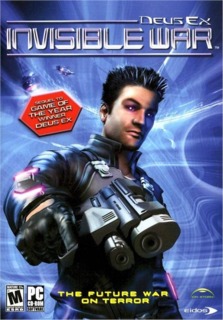Deus Ex: Invisible War
The unspoken irony is that the most inspirational symbol of humanity’s hope for the future, and one of the only genuinely nice characters you meet in this sequel to PC Gamer’s Best Game of 2000, is artificial — a perfect copy of an imperfect original.
And that goes for you as well. Playing as AlexD, the male or female (your choice) hero of Invisible War, you’re a clone who’s expected to carry on the legacy of your “older brother,” JC Denton. It’s been 20 years since the end of Deus Ex, and depending on whom you ask, the missing JC is either reviled or revered. Society suffers from the after-effects of The Great Collapse, a global depression blamed on his actions during the first game.
As the game starts, you’re enrolled in the Chicago branch of the Tarsus Academy, a training school for the cybernetically biomodified. The opening movie sets up the action: A terrorist disintegrates all of Chicago, forcing a last-minute evacuation of Tarsus to its facility in New Seattle. Is he after Tarsus? Is he after you? Or does he just hate Chicago? The answers to these questions, and many more, are eventually revealed (but not here).
The frustration in discussing Invisible War is that there’s so much you can’t discuss without giving away spoilers. Like its predecessor, this engrossing RPG is built on a conspiracy theorist’s house of cards. Plotlines and allegiances dovetail betwixt and between competing organizations, all clamoring for your compliance in restructuring humanity. There’s the WTO, a corporation with financial holdings in the status quo; the Order, a religious cult dedicated to personal fulfillment; the Omar, a cyborg clan that preaches better living through technology; and others, whose intentions may not be so clear.
Almost immediately, you’re presented with myriad choices, not the least of which is who to serve. Missions ranging from assassinating rivals to infiltrating bases are offered by NPCs, usually for cash rewards or biomods. These cybernetic upgrades (called “augmentations” in Deus Ex) can give you special powers such as enhanced strength, cloaking abilities, X-ray vision, and more.
How you proceed is up to you. As in Deus Ex, you’re given the tools to accommodate your personal play style, whether it’s blasting through the front door with guns a-blazing or sneaking around ventilator shafts avoiding contact. I can’t say that I pulled it off, but Ion Storm claims you can complete the entire game without killing anyone.
No doubt you’ve heard about the technical wizardry implemented in making Invisible War a true immersive simulation: real-time lighting, normal mapping (which gives greater depth to flat textures), ragdoll physics, and complex AI routines. And to be sure, it’s fun to fling dead bodies at walls just to watch them crumple into amusing poses. But the technological advances here are more like a dress rehearsal for Ion’s next game, Thief III, than a gameplay-altering improvement.
For example, the dynamic-lighting system that casts shadows on the fly certainly looks cool, and theoretically, you can hide from adversaries in the shifting darkness. The problem is, lights can’t be destroyed, and only some can be switched off. Likewise, all objects in the game have disproportionate mass. Even without enhanced strength, you can hoist cups, bodies, or explosive metal boxes like they were Styrofoam, and toss or kick each just as easily. Try throwing a lamp as a weapon, and it’ll bounce off your opponent. Unless you’ve augmented your strength, the damage done will be minimal.
Similarly, NPCs in Invisible War have the AI of idiot savants. They’re intelligent enough to investigate strange noises or engage in spontaneous small talk, but lack the smarts to take evasive action while being shot in the face. Too often, one will stand stiffly in front of you as it returns fire, ironically becoming more limber in death once the ragdoll physics take over.
And, as beautiful as the graphics are (the bloom effect gives every light source a subtle but highly realistic softness), they’re coated with a veneer of malaise. From the poshest apartment in New Seattle to the grimiest slum in Cairo, the game’s desolate color palette relies heavily on gray, brown, and tan. True, the post-apocalyptic future presented in Invisible War isn’t a cheerfully tropical one, but its bland sameness is more dyspeptic than dystopian.
Don’t get me wrong: Invisible War is still an excellent RPG, and with four different possible outcomes (plus one “secret” ending) and numerous side-quests, you can play it repeatedly without seeing everything. (I finished two of them.) But its rough edges keep it from being an Editors’ Choice–level game that everyone should play.
Among those “rough edges” are some fairly serious hardware issues. Framerates crawled on a PC with a mid-range GeForce 3D card, even at 800x600 resolution. Even a 3.2GHz machine with a GeForce FX 5950 had disappointing framerates at just 1024x768. (ATI cards fared much better with the latest 3.9 drivers.) I also experienced numerous game crashes that sent me back to the desktop, so save your games often. Future patches will undoubtedly fix these bugs (particularly for GeForce cards), but they collectively damage the sense of being lost in this hyper-realistic, immersive world.
With the right hardware, Invisible War offers a thought-provoking, multi-layered journey with a side order of free choice. Be warned, though: There are no light or dark sides to join, no “good” or “evil” options, only a rainbow of grays. Just pretend you’re reading a 10,000-page Choose Your Own Adventure edition of Conrad’s Heart of Darkness, and don’t panic when all paths eventually lead to ruin.

